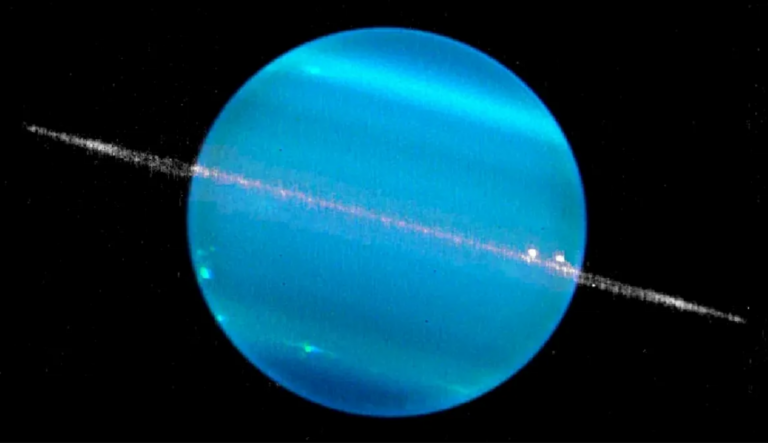Uranus remains a mysterious entity within our solar system, with limited knowledge about its characteristics. The Voyager 2 spacecraft’s expedition in 1986 marked the only encounter with this celestial body. One of the most intriguing aspects of Uranus is its axial tilt, which differs from the typical orientation observed in other planets.
While most planets have a relatively upright spin axis perpendicular to their orbit around the sun, Uranus deviates significantly by tilting almost perpendicular to its orbit. As a result, during its summer season, the north pole directly faces the sun. Additionally, unlike Saturn, Jupiter, and Neptune, which have horizontal rings encircling them, Uranus possesses vertical rings and satellites orbiting its inclined equator.
This ice giant exhibits a remarkably cold temperature regime and an irregular, off-center magnetic field, in contrast to the ordered, bar-magnet configuration seen in other planets like Earth or Jupiter. Scientists speculate that Uranus may have undergone a significant transformation from a configuration resembling other planets in the solar system to its current state, possibly due to a sudden inversion. Our recent study, published in the Astrophysical Journal and presented at a meeting of the American Geophysical Union, sheds light on this phenomenon.
Our study focused on the hypothesis suggesting that a cataclysmic collision served as the catalyst for Uranus‘s unique spin. During the early formation of the solar system, violent collisions among protoplanets significantly influenced the development of celestial bodies. It is widely believed that Uranus’s axial tilt originated from one such impactful collision. The aim of our research was to uncover the potential mechanisms driving this event.
While physically constructing and colliding planets in a laboratory remains beyond our current technological capabilities, we utilized advanced computer modeling to replicate these scenarios. By inputting equations that govern fundamental principles of physics, such as gravity and material pressure, we were able to recreate the dynamics of planetary collisions. This computational approach allowed us to investigate numerous collision scenarios and their resulting outcomes.
Our simulations suggest that a collision with a celestial body twice the mass of Earth could have caused Uranus’s unique axial tilt. In cases of grazing collisions, the material from the colliding body may form a thin, hot shell near the edge of Uranus’s icy mantle, below its hydrogen and helium atmosphere.
This event could hinder the mixing of materials within Uranus, resulting in the retention of heat from its formation deep within its core. This theory corresponds with the observed coldness of Uranus’s surface. While the thermal evolution of planets is intricate, the impact of large collisions in altering a planet’s internal and external dynamics is evident.
Furthermore, our research represents a significant advancement in computational capabilities. By utilizing modern supercomputers, especially with the SWIFT simulation code, we achieved unparalleled resolution in our simulations. This technological progress allowed us to explore uncharted territories and reveal intricate details related to planetary dynamics.
In addition to uncovering the mysteries of Uranus, our studies have implications for understanding planetary formation on a larger scale. Recent findings of exoplanets resembling Uranus and Neptune highlight the importance of our research. Insights gained from the evolution of our own ice giants contribute to our understanding of distant exoplanets and the potential habitability of other worlds.
Our simulations provide valuable insights into what happens to planetary atmospheres after a collision, which is crucial for determining the potential for extraterrestrial life. The expulsion of atmosphere and the subsequent bulging of the planet significantly reduce the chances of sustaining life-friendly conditions. However, the collision also brings in energy and materials that could lead to the formation of compounds favorable for life. Additionally, the introduction of rocky material from the colliding body’s core into the planetary atmosphere opens up possibilities for detecting trace elements that indicate similar impact events in the atmospheres of exoplanets.
Despite the progress made in understanding Uranus and the consequences of large impacts, there are still many unanswered questions. There is a growing push for new missions to Uranus and Neptune, driven by the need to uncover the mysteries surrounding these distant worlds. By combining observations, theoretical models, and computational simulations, we are getting closer to unraveling the enigma of Uranus and expanding our knowledge of the diverse planetary landscapes that exist in our universe.
Do not forget to share your opinion with us to provide you with the best posts !




0 Comments